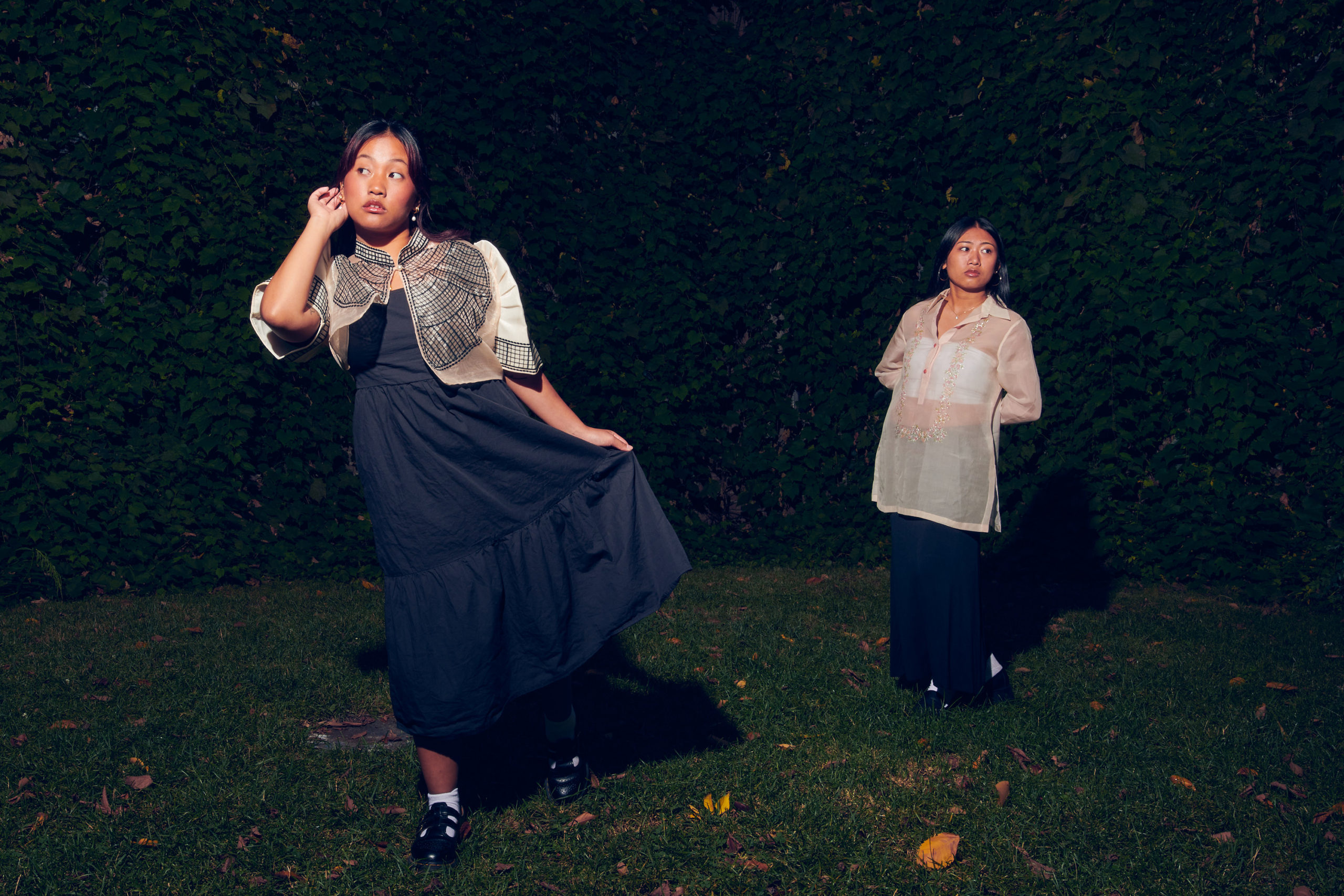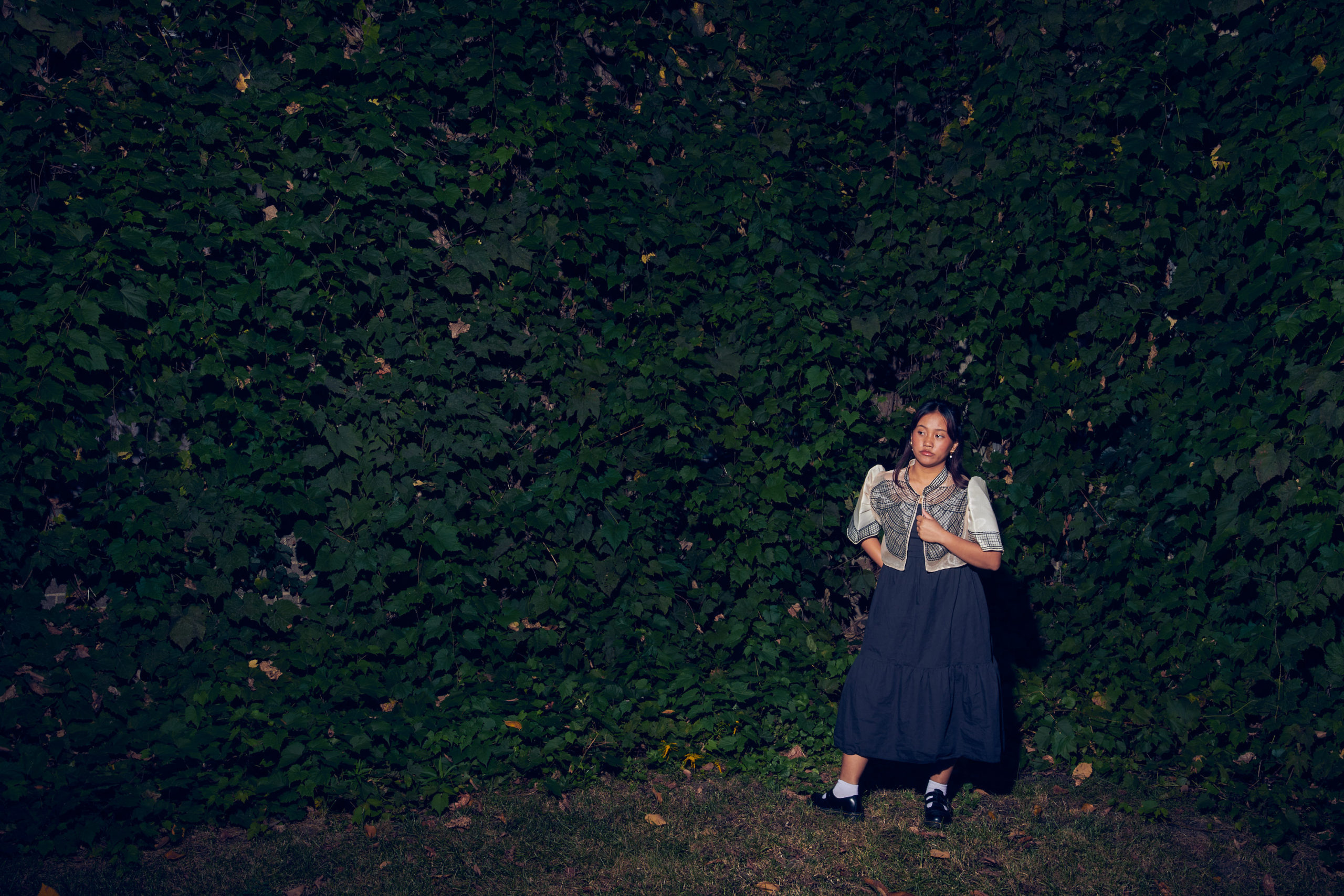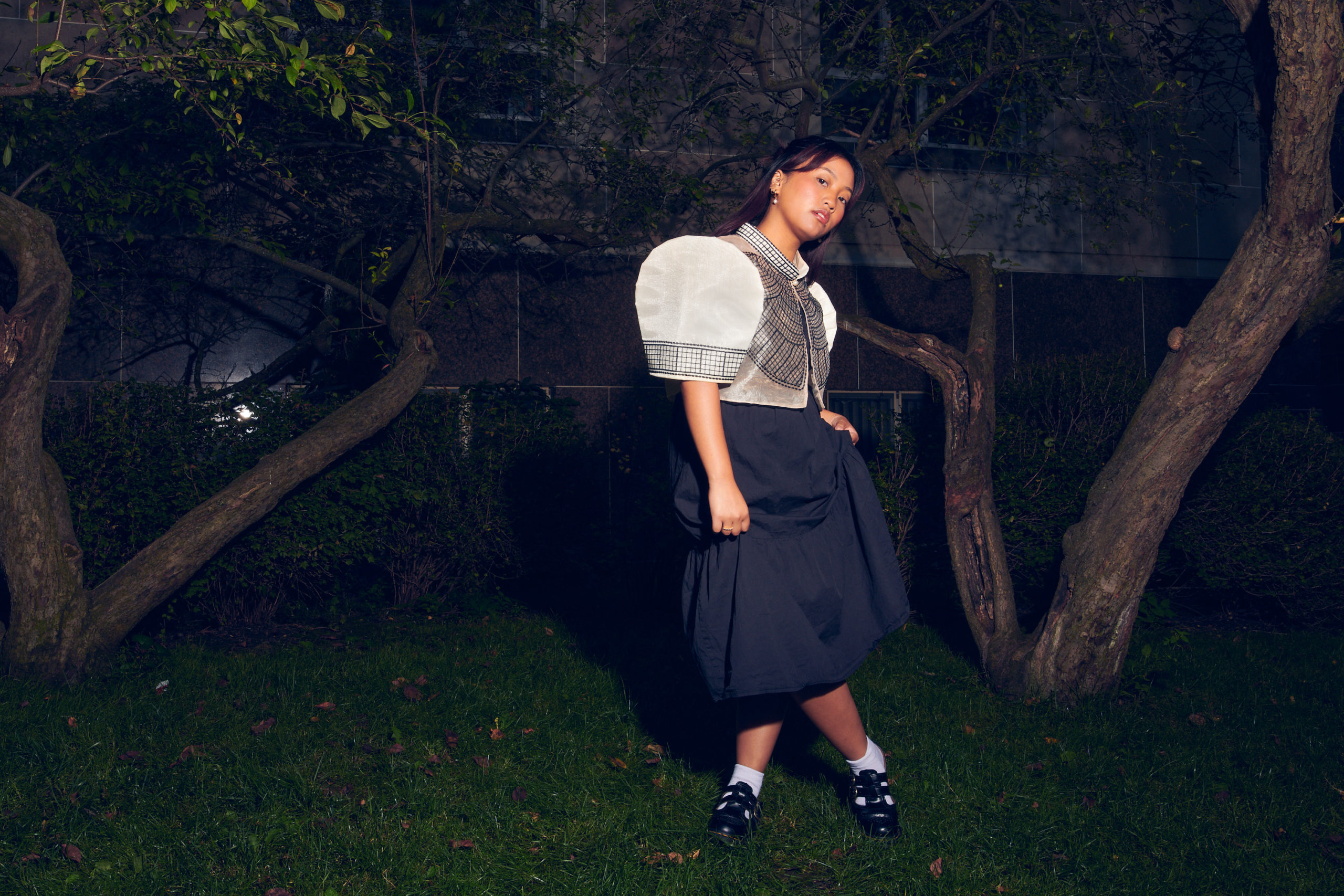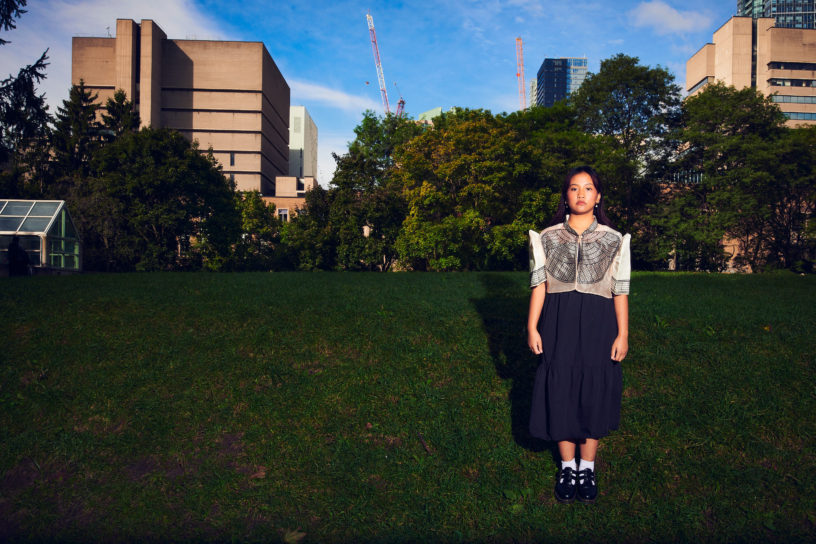Filipino fashion students at TMU are reclaiming the ideals of the Maria Clara as modern symbols of empowerment
By Teresa Valenton
Disclaimer: Teresa Valenton is the current co-president of the university’s Filipino Student Association but was social media associate at the time this article was written and reported.
Amidst the white walls of a small fashion studio lies a designer immersed in revitalizing the threads of Filipino history. Scraps of bridal dresses line the floors of Toronto Metropolitan University (TMU) fashion alumnus Jillian Joy San Juan’s workshop in East York. Smooth and shimmery silks adorn the bust mannequins with made-to-wear Filipinianas, various pieces characterized by pleated sleeves and butterfly-like silhouettes. Low hums of sewing machines vibrate through the room and the in-progress garments are spread across tables in the studio space. Chatter fills the front desk with talks of bridal designs, custom wedding pieces, alterations, fittings and all collaborative processes in-between. Her studio acts as a point of cultural revitalization for traditional Filipino garments in a post-colonial setting.
Widely known as the Filipiniana, this term describes one of many traditional garments worn in the Philippines. Interchangeably titled as the Maria Clara, it has become an ever-changing piece in Filipino history. The name comes from a character written by Jose Rizal, a novelist considered a national hero who narrated colonial ideals to Filipino women. Referred to as the ‘visible head of the Philippine nationalist movement’ by scholar Mark DeStephano, Rizal’s multiplatform work in both Spanish and Tagalog offered a vision of reform that united Filipinos during the revolution.
Denounced as the “greatest misfortune that has befallen the Filipina” by Rizal, the ideals of the Filipiniana have been complicated for women in the diaspora. Critics are unsure if Maria Clara was a satirical social comment in Rizal’s novel Noli Me Tángere as a symbol of purity and virtue. However, author Zea Asis describes her image as suppressive and sexist of what it meant to be a Filipina in the 20th century. In an effort to reclaim the garment as a symbol of empowerment, many fashion designers have taken it upon themselves to redefine its history.
San Juan’s first Filipiniana collection was a by-product of her time as an undergraduate student at TMU. Familiar to the walls of Kerr Hall, San Juan’s fascination with traditional clothing was not imminently apparent. Fast-approaching her graduating collection at the time, San Juan wished to create a body of work that was culturally relevant. Describing her ideas “within the Western society or within North America,” San Juan’s collection was designed to be viable in all markets.
Once familiar with her mother’s garment, a Terno from the Philippines, San Juan was able to picture the clothing in use. The Terno refers to the various components of the overall traditional Filipino dress. However, in its modern usage, many refer to the Terno as a synonym to the Filipiniana when they discuss the unique butterfly sleeves.
To further tap into her Filipino identity, San Juan set out on learning all about the garment. “I found that it was not really popular with people in North America and even within the Philippines, not many people were wearing it for everyday occasions,” she says. “There was a sort of movement that was pushing for this design into daily use. I just ended falling in love with it the more I researched and that is where it all began for me.”
Not limited to Canada alone, the Filipino diaspora is one of the largest, spanning over 100 countries as referenced by The Oxford Handbook of Asian American History. This makes the Philippines the third-largest population in Canada of ethnic or cultural origin from the Indo-Pacific region according to The Embassy of the Philippines in Ottawa.
However, many Filipino Canadians have expressed their strong sense of belonging in the diaspora. According to Statistics Canada, over nine in 10 Filipino Canadians (92 per cent) reported feeling a very strong sense of belonging in Canada. Often referred to by Filipino Canadians as ‘balikbayans’ which roughly translates to “return to country,” the community has forged localised cultures worldwide. As their overseas populations continue to grow, it is no surprise that the diaspora is seeking a deeper understanding of their roots.

(SAMMY KOGAN/THE EYEOPENER)
Though the Maria Clara was meant to embody the ideal Filipina, the evolution of the garment reflects history. For fourth-year fashion student Jasmine Tolentino, the design process spans studios both on and off campus. Sitting in a plastic blue chair hunched over wooden tables alongside her peers, she carefully stitches denim together for her final menswear project for the Advanced Fashion Design II core elective. As the lights dim down at the end of the day and grey curtains close at the turn of sunset, she keeps working, finding solace immersed in her work. Faint music from headphones around the room passes through the silence and Tolentino pushes through as one of many aspiring designers.
However, it is her generational resilience that pushes her to work harder. “I recently learned from my dad that my great-great-grandpa was a dressmaker or tailor in Pampanga. I found it interesting that this was already in my blood and that I wasn’t the first one,” Tolentino says, paying homage to her family.
Aside from family, she expresses an unfamiliarity with Filipino designers. Primarily surrounded by Western artists, the reinvention of traditional wear was a land undiscovered for the young designer. “I think it’s great that many have modern takes on our culture as long as they are mindful of what they’re adding and changing.”
Although the Filipiniana is modernly known as the traditional dress of the Philippines, it only reflects those of upper social classes. “There was a difference in how Indigenous women dressed as well. It is just like any society where our clothes normally define who we are, what classes we belong to,” says Mignette Garvida, a Spanish language lecturer at TMU. Materials for Indigenous dresses heavily differed from Maria Claras, with skirts made from silks of varying colours and blouses composed of pineapple fibres and intricately embroidered details, she explains.
Partially deriving from the baro’t saya or “blouse and skirt,” the Terno encompasses a variety of styles. “When it came to the middle class, styles were a bit different. Silks from China entered the Philippines long before the Spaniards came. So when the Spaniards came, the styles changed as well,” says Garvida.
“They say that the
history of a dress is
also the history
of a nation“
As Tolentino enters her final year of studies, her perception of the Maria Clara progresses with time. After her internship with a Toronto-based Filipina designer and time spent researching the Filipiniana, her pre-conceived notions of the garment being a “neutral, conservative piece of clothing,” have now evolved to see it as a signifier of “resilience, beauty and strength.” She says “it’s important that the Filipino diaspora keeps in contact with traditional wear to learn more about their roots and the meaning behind these important cultural pieces.”
Now set up in the corner of her bedroom, a white sewing machine and serger are propped up on a wooden desk. White, grey and light pink threads adorn the left corner of her white peg board beside several rulers, two claw clips and a lamp that illuminates her late nights. The black lamp lights the space ever so slightly giving each piece a touch of tenderness and familiarity. With an emphasis on having her family continuously be an inspiration to her work, a four-cut photo strip of her family graces the middle of her stand in the eyeline of her seat.
This small yet familiar setup will be put to use as Tolentino reclaims her identity as a Filipina in the world of fashion. Like Tolentino, other creatives are also exploring their heritage through various outlets. This path to cultural discovery is not linear and can often be halted by external influences.
Filipina Indonesian writer and independent researcher Bianca Weeko Martin has dedicated her work to design, art and Filipino culture. Her academic focus is on how cultural practices in the home can be healing through history and has extended to collaborations with creatives in Toronto. Martin’s research has helped her to become a celebrated figure among many Filipinos both in the Philippines and in Canada. Her latest Canadian release of the Architectural Guide in Manila was published on Sept. 7.
Despite her specialisation in history, Martin acknowledges the overlap between clothing and architecture and the ways in which they intersect with culture. “I think when we grasp identity, there are so many questions and non-objective routes to information. How do we feel? How do we remember?” she pushes.
Though the histories between the two disciplines differ, she says the ways materials are used constantly reflect functionality. “When you think about migration stories, there’s factual evidence and objective information that is helpful about identity.”
Fashion and books have become a pinnacle of cultural exchange. While the diaspora can look different for many, it is these exact art forms that keep youth interested in pushing themselves further. Clothing often tells the unspoken stories of women across countries, generations and patterns of immigration. In Martin’s case, she acknowledges that there may be information gaps when it comes to innovating traditional Filipino-wear into empowering garments. “How are we spotlighting things that are happening there? How do we place it alongside our work in the diaspora so that they are not completely alienated?” she asks.

(SAMMY KOGAN/THE EYEOPENER)
Though Maria Clara ideals have historically suppressed Filipino women as argured by Asis, it is the same term that has united communities to look ahead. Even in border towns on the edge of Southwestern Ontario, there lies a young woman who is contributing to change in the Filipino community. Raised in Sarnia, Isabela Gorgonio faces a constant battle with her identity. There was a lack of cultural foundation that came from a predominantly white graduating class, she says.
But a greater battle to be faced was the struggle among other Filipinos. “Especially in smaller communities, there’s such a huge emphasis on knowing, needing to learn or understanding the language to prove yourself as a Filipino,” she says.
Now five years later, sitting in her apartment in Toronto surrounded by posters of various artists, succulents and a rack full of eccentric clothing, Gorgonio is unapologetically herself. Attending TMU as a fourth-year fashion student and doubling down as the former president of the Filipino Student Association at Toronto Metropolitan University (FILMET), she effortlessly embodies the ever-changing definition of the Maria Clara. While on path to pursuing a career as a creative director, she says it is important to keep tradition at the forefront of her work. With an understanding that fashion may appear frivolous in nature, Gorgonio continuously pushes for an agenda that centres culture in clothing. She says, “fashion alone is a perfect visual signifier to say, ‘this is who I am’ without saying a word to anyone. So I think it’s even more important to understand the rich histories of these pieces.”
“Whenever I wear traditional clothing,
I feel like my lola
would be proud“
On set for her final assignment for Art Direction for Fashion, she positions models dressed in the Filipiniana with unconventional hair and makeup styles. Embellished in traditional wear, each model interacts with beauty ideals differently. “Even if you relate back to history, people with lighter skin would be the ones to wear these pieces,” she explains. Alliya Anne G. Lopez, who has a bachelor of fine arts in visual studies from the University of Calgary, reports that colourism remains so deeply rooted in the Filipino diaspora. Alongside heavily Spanish-influenced pieces, Gorgonio encouraged the models to celebrate their darker skin tones in spite of historically-rooted biases.
To take modernity into account when styling her shoots, Gorgonio has always sought to reclaim her heritage in a way that creates inclusive spaces for all. When reflecting on her journey as a creative thus far, she explains, “there’s sometimes the internal battle of pouring your heart into something and then detaching your identity. I think no matter what you do, your identity will have a strong component on what you create, even on a surface level.”
Regardless of designer, the Filipiniana will always carry an unmatched poise. The sleeves command an attentive eye and the fabrics hold many intergenerational stories. Out of many garments written in Philippine history, the Maria Clara holds dear to the ideals of femininity. Slowly overcoming these sexist stigmas, local Filipino designers have conspired together to deconstruct this image. Gorgonio, however, puts it proudly, “whenever I wear traditional clothing, I feel like my lola would be proud. I think about my ancestors and I think about all those who came before me, which is so beautiful.”
“I’m first-generation but some people have been here for two or three. It is all so different,” says Martin, elaborating on reconciling with a cultural divide. “We’re all dealing with similar ideas, questions and parts of history and trauma.

(SAMMY KOGAN/THE EYEOPENER)
Back at her studio, San Juan’s tale of cultural discovery begins with fashion. Surrounded by Filipino-wear throughout her upbringing, she always associated traditional pieces with family. “I imagined it as something specifically for events as opposed to something of everyday attire,” she explains.
As her interest grew with research, San Juan was introduced to a world of history surrounding the Filipiniana. “There were politicians who were a bit wealthier, but there were also people working laboriously on the streets as well [wearing] Ternos. Just uncovering that truth and history where it came from changed my outlook and inspired me to share with others that the Filipiniana can exist beyond.”
Now specialising in custom and ready-to-wear Filipinianas for brides, San Juan’s clientele has expanded across cities in North America. Apart from custom pieces, she has made it known that designing is a collaborative process. Often seen in conversation with clients at her front desk, she listens intently to their requests to create an empowering piece of work.
San Juan says, “They say that the history of a dress is also the history of a nation. Upon hearing that and learning about the Terno, I think it does reflect the state of the country. It evolved from the Spaniard colonial silhouette, but it also gave me a much better understanding of what it meant to be Filipino.”











Leave a Reply